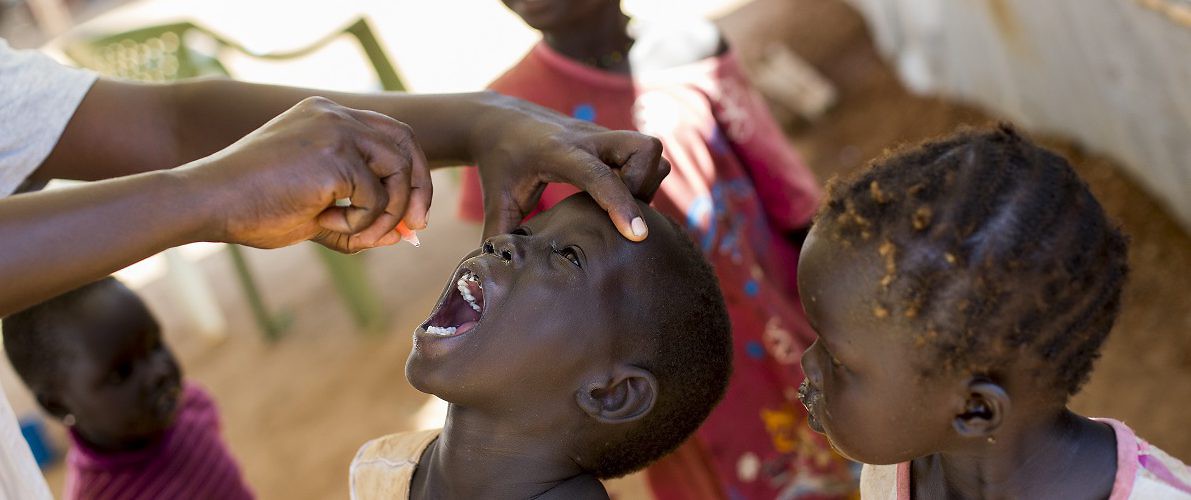Polio vaccinations are administered with World Health Organization support at a South Sudan UN site. Juba, South Sudan, December 5, 2014 (JC McIlwaine/UN Photo)
Who designs global health institutions, who pays for them, and whom do they serve? The answers to these questions have grown increasingly complex in recent decades, as the number of institutions multiplied, expanded to encompass new sectors, and acquired renewed importance in the fight against AIDS, SARS, Ebola, and other infectious diseases. In Governing Global Health: Who Runs the World and Why? Vice Chair of the Clinton Foundation, Chelsea Clinton, and University of Edinburgh Professor of Global Public Health, Devi Sridhar, offer a rare accumulation of practical and academic insight into their answers, and the ramifications for a quickly changing field.
The book examines the inner workings of four of the biggest players in global health, including two “traditional” institutions—the World Health Organization (WHO) and World Bank—and their younger cousins, known as public-private partnerships (PPPs)—the Global Fund to Fight Aids, Tuberculosis, and Malaria; and Gavi, the Vaccine Alliance. Formed in the early 2000s as a reaction to the perceived inefficiencies of the traditional institutions, PPPs were established to create more results-oriented, vertical funding mechanisms for specific disease interventions. Unlike their state-centric counterparts, PPPs include private sector and philanthropic representation in their voting mechanisms and on their boards (e.g. the Bill and Melinda Gates Foundation). While ample analysis of traditional intergovernmental organizations exists, little data has been collected on PPPs until now.
A recurring theme in the book is disruption and innovation in response to a shifting public health landscape. To frame their case selection, the authors begin with an examination of recent infectious disease outbreaks, including the 2014 Ebola outbreak and 2015 spread of the Zika virus, which were both strong catalysts for global health cooperation. Noting that the organizations they study lack the political sway typically associated with the “high politics” of security issues—none have the ability to impose sanctions—Clinton and Sridhar frame a central conundrum facing global health institutions today: They bear responsibility for issues central to safety and security, yet lack the enforcement mechanisms to see policies through.
The disruptive presence of PPPs is tightly interwoven with governance shifts that render the contemporary landscape fragmented. Clinton and Sridhar parse these shifts in a clear and accessible manner. They argue that the move towards a partnership model is part of a trend by donors to realign their objectives with, and tighten monitoring and control over, implementing agencies. Spilling over to traditional institutions, this phenomenon helps to explain why nearly 80% of WHO’s overall budget was earmarked by donors for specific purposes in 2015, compared to 18% in 1970—a trend mirrored elsewhere in the United Nations system.
While Governing Global Health’s academic contributions are more exploratory than explanatory, the book makes a notable contribution to international relations theory that deserves to be further developed and will hopefully inspire future scholarship. The authors offer an overdue update to a commonly used framework in global governance research by refashioning “principal-agent theory,” a rationalist approach which casts member states as principals who delegate tasks to international organization agents.
Frequently applied in studies of multilateral aid, the theory fails to adequately capture the dynamics of modern governance structures: Even traditional health institutions receive much of their directives and funding from private sector and philanthropic actors. For instance, the Gates Foundation provided WHO with nearly the same amount in earmarked contributions ($516 million) as the US government ($573 million) in 2014/15. Clinton and Sridhar amend the framework to acknowledge this, re-casting private and philanthropic actors as principals.
The authors go on to speculate that the continued relevance of PPPs is because “their core principals have continued to shape their priorities and structures.” Here a link is made between inclusive governance (i.e. the involvement of private and philanthropic actors) and a willingness to engage in meaningful reform—whereas WHO, following decades of stalled reform, is portrayed as a clear counterexample.
Governing Global Health’s greatest strength lies in its rich empirical basis. The repository of data upon which the authors draw goes unrivaled by similar scholarship, and they build an engaging narrative from the often dry necessities of budgeting technicalities and organizational structure. Producing analysis of this kind requires insider knowledge and access to global health institutions; to this end, the authors draw on their wide-ranging policy experience and connections in the global health field. Any bias inherent to the authors’ particular vantage point is fully disclosed and deftly handled. Ideally the data accumulated here will create opportunity for other scholars to weigh in.
Theoretically, while the book establishes a significant pivot in approaches to principal-agent theory, it leaves lingering questions regarding the implications of this change—and much space for future research to address them. For instance, the authors do not adequately address how philanthropic and private sector actors serving on boards of PPPs may be cast as principals and agents simultaneously. In this manner, the book highlights the need for further global health governance research to bridge gaps between rationalist and constructivist theories.
Governing Global Health provides a timely and practical handbook which elucidates the current state of global health governance, replete with original, clearly visualized data, and cogent policy proposals for continued improvement of the global health architecture. It additionally strengthens the tenuous bridge between the fields of global health and political science, an area exhibiting growing need for policy-relevant scholarship. On the whole, Clinton and Sridhar fill a key empirical gap for academics and practitioners alike, underscoring the complexity, fragmentation, and challenges that characterize 21st century global health governance.
Summer Marion is a doctoral student in the Department of Political Science at Northeastern University and research affiliate of the Harvard Humanitarian Initiative. Michael R. Snyder is an independent analyst and regular contributor to the Global Observatory.





